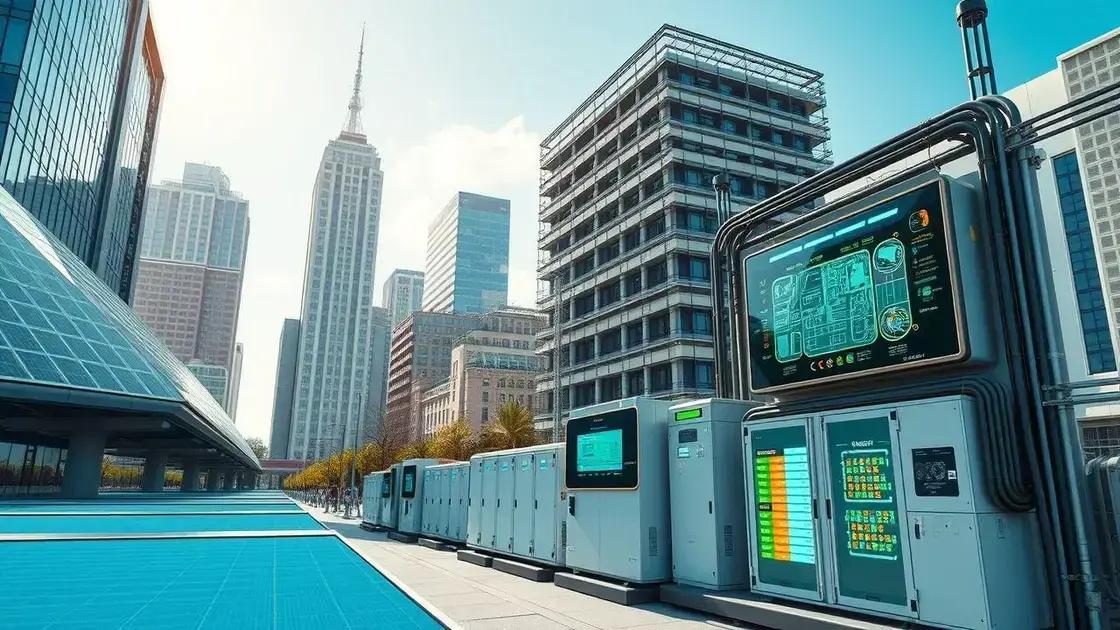Insights on clean energy projects usa: what you need to know

Insights on clean energy projects in the USA reveal that advancements in solar energy, energy storage, and smart grids are driving a shift towards sustainable energy solutions, while community engagement plays a vital role in their success.
Insights on clean energy projects usa are essential for anyone interested in sustainability and innovation. Have you ever wondered how these projects impact the environment and economy? Let’s dive deeper into this vital topic.
Understanding clean energy projects in the USA
Understanding clean energy projects in the USA is crucial as we face environmental challenges. These projects are vital for reducing carbon footprints and promoting sustainability.
The USA has seen significant investments in various clean energy sources. This includes solar, wind, and hydroelectric energy. Each of these sources contributes uniquely to the energy landscape.
Types of Clean Energy Sources
There are numerous avenues to explore within the clean energy sector. Let’s look at a few prominent types:
- Solar Energy: Harnessed through solar panels, it converts sunlight into electricity.
- Wind Energy: Generated by wind turbines, it utilizes the power of wind to produce energy.
- Hydroelectric Energy: This type creates electricity from flowing water, often through dams.
- Geothermal Energy: This source uses heat from within the Earth to generate power.
These sources not only help in creating cleaner energy but also support jobs and economic growth. As various states adopt these technologies, community involvement becomes vital. People often participate in local clean energy initiatives, ensuring their voices are heard in energy planning.
Benefits of Clean Energy Projects
The benefits of clean energy projects are extensive. For one, they lead to cleaner air and lower greenhouse gas emissions. This directly impacts public health. Moreover, clean energy can also provide economic benefits, such as job creation in emerging industries.
Additionally, investing in renewables reduces dependence on fossil fuels. This transition is critical for energy security. Schools and businesses are increasingly looking at these alternatives to promote sustainability in their operations. This can be a win-win for both the environment and local communities.
In conclusion, understanding clean energy projects in the USA equips us to take part in this transformation. These projects are not only vital for the planet but are essential for future generations, encouraging active participation from everyone.
Key players in the clean energy sector

Key players in the clean energy sector are pivotal in driving innovation and implementation of sustainable practices. Understanding who these players are helps us appreciate their roles in the energy landscape.
Among the main players are government agencies, private companies, and non-profit organizations. Each contributes uniquely to the development and promotion of clean energy initiatives.
Government Agencies
Federal, state, and local governments have a strong influence on clean energy policies. They provide funding and set regulations that encourage renewable energy adoption. Here are several key functions they perform:
- Implementing renewable energy standards.
- Offering subsidies and incentives to promote clean energy projects.
- Funding research and development in clean technologies.
- Conducting public awareness campaigns to educate citizens about clean energy.
These government efforts are essential for fostering a supportive environment for clean energy growth.
Private Companies
Many private companies are at the forefront of the clean energy movement. They develop technologies and provide solutions that expand the clean energy market. For instance, companies specializing in solar panels, wind turbines, and energy storage play a significant role in shaping the industry.
These companies not only innovate but also create jobs and drive economic growth. Businesses are increasingly recognizing the importance of integrating sustainability into their operations. This shift leads to more investment in clean energy technologies.
Non-Profit Organizations
Non-profit organizations advocate for clean energy policies and support community-based projects. They often serve as a bridge between the public and private sectors, helping to raise awareness about clean energy and pushing for policy changes that benefit the environment.
By collaborating with various stakeholders, these organizations help educate the public and promote initiatives that ensure a cleaner, greener future.
In summary, identifying the key players in the clean energy sector provides insight into the collective effort required to advance sustainable energy solutions. Each player, whether government, private business, or non-profit organization, plays a crucial role in building a more sustainable world.
Challenges faced by clean energy initiatives
Challenges faced by clean energy initiatives can significantly impact their success. Understanding these obstacles is crucial for effective implementation and scaling of clean energy solutions.
One major challenge is financing. Many clean energy projects require substantial upfront investments. Securing funding can be difficult, especially for smaller companies. Traditional financial institutions may be hesitant to invest in new technologies that have uncertain returns.
Regulatory Hurdles
Regulatory issues also pose significant barriers. Different states have varying laws regarding clean energy implementation. Navigating these regulations can be complex. Some key regulatory challenges include:
- Inconsistent state policies on renewable energy.
- Complicated permitting processes that delay project launches.
- Utility regulations that hinder competition among providers.
- Changing federal policies that impact funding and incentives.
These regulatory challenges can create uncertainty and slow down the adoption of clean energy technologies.
Technological Obstacles
Technological challenges are another aspect to consider. While advancements in clean energy technologies are rapid, some solutions still face issues related to efficiency and reliability. New technologies require ongoing research and testing. For instance, energy storage systems are essential for managing the intermittent nature of renewable energy sources. Improving their efficiency and reducing costs is critical for broader usage.
Public perception can also be a challenge. Some communities may be resistant to new energy projects due to concerns about aesthetics or potential impacts on property values. Engaging with communities through education and open dialogue is essential to address these concerns effectively.
As clean energy initiatives grow in importance, overcoming these challenges is essential to creating a sustainable future. By addressing financial, regulatory, technological, and societal obstacles, stakeholders can work towards a cleaner energy landscape for all.
Future trends in clean energy projects

Future trends in clean energy projects showcase the direction of our energy systems. As technology advances and society becomes more aware of the environmental impacts, new developments are on the horizon.
One significant trend is the growth of solar energy. Solar panels are becoming more efficient and affordable. This makes them accessible to both homes and businesses. Innovations in solar technology, such as solar shingles, blend seamlessly into roofs, making solar energy aesthetically pleasing.
Energy Storage Solutions
Energy storage is another vital area of advancement. As reliance on renewable sources increases, efficient storage systems are essential. Batteries like lithium-ion are being enhanced to store more energy at lower costs. Here are key benefits of improved energy storage:
- Greater reliability in energy supply.
- Support for the intermittent nature of renewable sources.
- Ability to shift energy use to off-peak hours.
- Facilitation of energy trading in a decentralized grid.
This trend supports the integration of renewables into the overall energy mix.
Smart Grid Technology
The implementation of smart grid technology is changing how we produce and consume energy. Smart grids use advanced communication technologies to improve efficiency. These systems help manage and optimize energy use. They allow for real-time data analysis, enabling better forecasting and demand response. This means that users can better control their energy consumption, lowering costs and emissions.
Across the globe, governments and companies are investing in clean energy infrastructure. Partnerships between private and public sectors are becoming more common, enabling larger projects. Notably, community solar projects are on the rise. These allow communities to share the benefits of solar energy without requiring individual installations.
As we look to the future, the combination of innovative technologies and sustainable practices promises to reshape our energy landscape. Being informed about these trends will prepare us for the changes ahead.
FAQ – Frequently Asked Questions about Clean Energy Projects
What are some common sources of clean energy?
Common sources of clean energy include solar, wind, hydroelectric, and geothermal energy, each contributing to a more sustainable energy system.
How does energy storage benefit clean energy initiatives?
Energy storage allows for the efficient management of renewable resources, ensuring a reliable supply even when generation is low, such as during cloudy days for solar energy.
What is a smart grid?
A smart grid is an advanced electrical grid that uses technology to optimize energy production and consumption, enhancing efficiency and reliability while reducing costs.
Why is community involvement important in clean energy projects?
Community involvement is crucial as it builds support, encourages local investment, and ensures that projects align with the needs and values of the people they affect.





